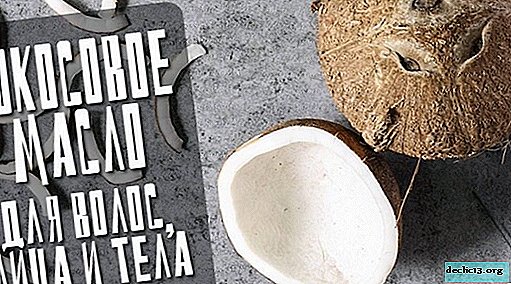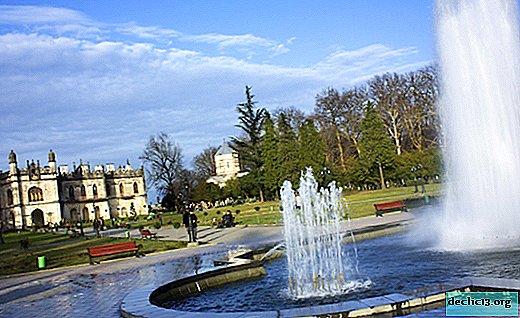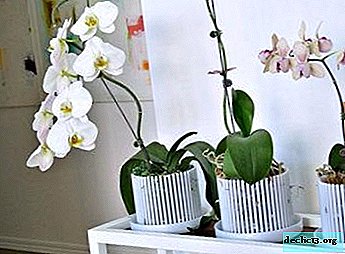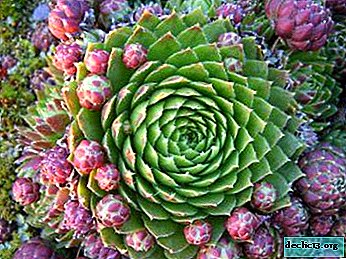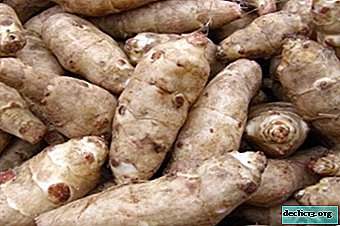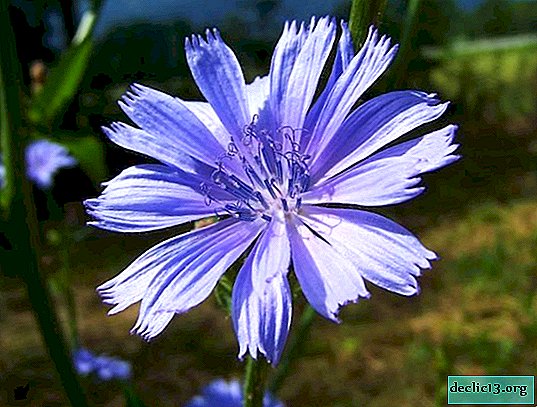All about the root of parsnip: description and composition, photos, useful and medicinal properties, application and other nuances
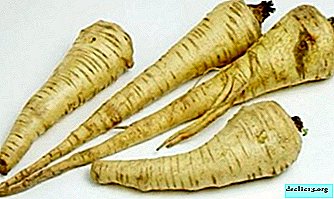
The benefits of parsnip root are known to many. Even our ancestors used it to treat many ailments. All thanks to biologically active and useful substances in its composition.
However, not many people know that it must be used with extreme caution. From the article you will learn about its benefits, the rules for use in various fields, and you will also see a photo of the plant.
Botanical definition and description
Thick root vegetable garden of many years of culture. It has a fleshy structure. The length of the parsnip root can reach from 14 to 25 centimeters. As for the color, most often such a root has a white, and sometimes cream, hue. It has a pleasant spicy aroma and a sweet taste.
Chemical composition
Calorie content 100 grams of parsnip root - 47 kcal.
100 grams of product contains:
- Protein - 1.4 g.
- Fat - 0.5 g.
- Carbohydrates - 9.2 g.
- Organic acids - 0.1 g.
- Dietary fiber - 4.5 g.
- Water - 83 g.
- Ash - 1.3 g.
Vitamin Composition:

- A, RE - 3 μg;
- beta Carotene - 0.02 mg;
- thiamine (B1) - 0.08 mg;
- riboflavin (B2) - 0.09 mg;
- pantothenic acid (B5) - 0.5 mg;
- pyridoxine (B6) - 0.11 mg;
- folate (B9) - 20 mcg;
- ascorbic acid (C) - 20 mg;
- tocopherol (E) - 0.8 mg;
- biotin (H) - 0.1 μg;
- phylloquinone (K) - 22.5 mcg;
- PP - 1.2 mg;
- Niacin - 0.9 mg.
Parsnip root is rich in such macronutrients:
- potassium - 529 mg;
- calcium - 27 mg;
- silicon - 26 mg;
- magnesium - 22 mg;
- sodium - 4 mg;
- sulfur - 12 mg;
- phosphorus - 53 mg;
- chlorine - 30 mg.
Of the trace elements it contains:
- aluminum - 493 mcg;
- boron - 64 mcg;
- vanadium - 80 mcg;
- iron - 0.6 mg;
- iodine - 0.25 mcg;
- cobalt - 3 mcg;
- lithium - 25 mcg;
- Manganese - 0.56 mg;
- copper - 120 mcg;
- molybdenum - 4 mcg;
- nickel - 4 mcg;
- rubidium - 44 mcg;
- selenium - 1.8 mcg;
- fluorine - 70 mcg;
- chromium - 1 mcg;
- zinc - 0.59 mcg.
Digestible carbohydrates:
- starch - 4g;
- mono and disaccharides - 5.2 g.
Acids:
- saturated fatty - 0.1 g;
- omega-3 - 0.003 g;
- omega-6 - 0.041 g.
Appearance and how is it different from parsley, can it be replaced?
Parsnip root and parsley are distinguishable in appearance and smell. Parsnip root is thick. It has a wide upper part and a pronounced thin "tail" underneath. Parsley root looks very different. It is long, even and tapers towards the end.
As for the smell, then the smell of parsley and parsnip root are similar, therefore, can be replaced in dishes, although parsley aroma is more pronounced. Another difference between plants is their use. For example, parsley is often used as a spice, but parsnip root is not the best option for seasoning. We will consider methods of its application below.
Photo
Further on the photo you can see how the root grows and looks:





Useful properties and contraindications
It is used for the manufacture of pharmaceuticals.
The root has many beneficial effects on the body.:
- reduces pain in hepatic colic due to its antispasmodic property;
- strengthens the immune system and tone the body;
- eliminates hallucinations in people with mental disorders;
- treats cough;
- neutralizes age spots;
- improves skin;
- used for the prevention of heart disease;
- lowers glucose and cholesterol;
- relieves colds and viral diseases;
- improves digestion;
- removes toxins and toxins;
- improves potency;
- relieves inflammation of the pelvic organs.
Scientists have proven its aroma improves mood and increases concentration.
Also, the positive properties of parsnip root can be attributed:
- help against baldness;
- the provision of a diuretic effect;
- the ability to dissolve kidney stones;
- treatment of lung and brain diseases;
- nail strengthening.
As for the negative health effects of root crops, no such cases have been detected. It does not even cause allergies.
Application
Cookery
Thanks to a pleasant fresh, spicy and sweet taste, as well as a pleasant aroma, the root is used for salads, soups, main dishes. They are even used to create marinades. Very widely used for salting.
Dermatology
Grated root is used to treat serious skin conditions.. These include psoriasis and even vitiligo. On the basis of the root, infusions and decoctions are made, which can have both external and internal applications.
It is also important that the use of parsnip root in food can prevent the appearance of wrinkles.
Cosmetology
 Tincture from parsnip root helps in the fight against acne. Due to its rich composition, namely the presence of calcium, sulfur and phosphorus in it, this vegetable will eliminate damage to bone and cartilage tissues.
Tincture from parsnip root helps in the fight against acne. Due to its rich composition, namely the presence of calcium, sulfur and phosphorus in it, this vegetable will eliminate damage to bone and cartilage tissues.
Do not omit its importance for hair and nails. The root is able to strengthen hair and nails, as well as improve their growth.
It is indispensable for those who are trying to cope with baldness. Having prepared a simple tincture based on the root, you can get rid of bald spots. This tincture awakens the hair follicles, preventing baldness.
The medicine
Digestive organs
The composition of the parsnip root contains a large amount of essential oils that help the formation of gastric juice. As a result, there is an increase in appetite and activation of the process of digestion of food. Its benefits are high in diseases and inflammation of the gallbladder. Due to its low calorie content, it is often used for weight loss.
Important! You can not eat the root in the presence of an ulcer. In this case, symptoms will worsen.Hormonal background
There is an improvement in the functioning of the endocrine glands due to the presence of biologically active substances in the root crop. They also stimulate the production of enzymes that increase the formation of certain hormones.
Excretory system and pelvic organs
- Dissolves stones.
- Prevents secondary absorption of urine into the blood.
- Removes sand from the kidneys.
If you have a pronounced urolithiasis, then this product is contraindicated to you, since it stimulates the passage of stones.
Respiratory system
 Eating parsnip root for food can help with diseases such as:
Eating parsnip root for food can help with diseases such as:
- asthma;
- tuberculosis;
- emphysema;
- tracheitis;
- pharyngitis;
- bronchitis.
Step-by-step treatment instructions
Potency strengthening
Would need:
- crushed root - 2 tbsp;
- honey or sugar;
- boiling water - 250 ml.
Pour the crushed root with boiling water. Strain after 2 hours. It is necessary to take it with honey or sugar 15 minutes before a meal, 4 times a third of a glass.
Restoration of bone and cartilage
Would need:
- root - 250 gr;
- lemon - 3 pcs;
- garlic - 120 gr.
- All ingredients are crushed and mixed.
- Next, the mass is placed in a glass jar with a volume of three liters.
- Then pour the mass with boiling water to the top.
- The container is wrapped and insisted for 8 to 10 hours.
You need to consume 70 grams of infusion 3 times a day, half an hour before a meal. The duration of the course is 3-4 months.
Cardiovascular Disease Prevention
 Would need:
Would need:
- parsley - 30 g;
- parsnip root - 100 g;
- valerian root - 5 g;
- honey - 2 tsp;
- parsnip root juice.
- Pour parsley, parsnip and valerian roots with 200 ml of boiling water.
- The liquid should be infused for an hour.
- Strain after time.
- Add juice from parsnip root and honey to the infusion.
Taken on a course of 21 days, 3 tbsp. an hour before meals, no more than 2-3 times a day.
To recover from operations
Would need:
- parsnip root -1 pc;
- honey to taste.
Squeeze the juice from the root of the vegetable. To improve the taste, add honey and mix well. Take 1 tablespoon three times a day 30 minutes before a meal.
Use for complementary foods
The parsnip root is also of great benefit to children. He is able to increase the baby's appetite, as well as normalize the digestive tract. Using it as complementary foods will help the baby quickly adapt to the diversity of adult food.
Important! If you decide to introduce the baby to the root of the parsnip, then you must consider that it has a diuretic property.It will not cause any discomfort as an addition to a soup or a second dish in the amount of a single serving. However, if you plan to give mashed potatoes from the root of the parsnip, then it is better not to do this before a walk, sleep, or trip, so that there is no trouble with natural need.
It is best to start complementary foods in raw or processed form at the age of 7-8 monthswhen the child is already familiar with all the usual vegetables.
Parsnip root can be safely called a storehouse of substances useful to the body. You can long list all its benefits to humans. But still, do not forget about caution. If you have weak immunity or you have medical contraindications, then you need to be extremely careful with the use of parsnip root.

